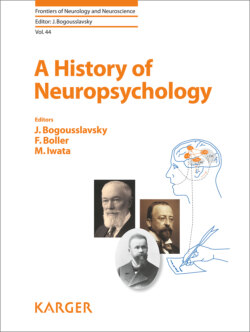Читать книгу A History of Neuropsychology - Группа авторов - Страница 32
На сайте Литреса книга снята с продажи.
Introduction
ОглавлениеStarting in the 19th century, human behavior has been the subject of abundant studies and to a range of definitions. In neurology and neuropsychology, behavior refers to the way human beings act and make decisions in contact with their environment. Neurobehavioral impairment (for simplicity purposes, we shall only use the term “behavioral” in the following) is therefore defined as a pathology, following brain lesion, that impacts the interactions between the individual and his/her surrounding social world.
Inherent to the nature of clinical examination, behavioral assessment belongs nowadays formally to guidelines and recommendations for most neurological diseases. For example, the fifth major revision of the Diagnostic and Statistical Manual of Mental Disorders (DSM-5) has not only included behavior change as a criterion in the diagnosis of neurocognitive impairment, but has also determined social cognition as one of the cognitive domains to be assessed [1].
First descriptions of behavioral disorders including neuroanatomical correlates date back to the mid-19th century [2]. However, attempts towards their systematic identification and analysis only began around the turn of the 19th to 20th century. Some authors have argued that interest in the neural basis of behavior and moral reasoning might have been delayed due to the particular taboos existing at that time [3]. In an editorial about the frontal lobe and behavior, Mesulam discussed the difficulties encountered in behavioral assessments [4]. He first denoted the variety and complexity of behavioral deficits. Despite certain shared features, the panel of behavioral changes observable after brain lesions thus remains difficult to explain; despite numerous studies in the field over the last decades, a unified, widely accepted model is still lacking. Second, behavioral changes are generally difficult to quantify by standard testing. They are not always evident – and can be overlooked due to well-preserved performance on routine examination. Moreover, behavioral deficits evolve (acute vs. chronic stages), can fluctuate under certain circumstances, and may be contained in the examination room (e.g., due to external control). Finally, any occurring changes must be evaluated against the background of pre-morbid personality traits “rather than in reference to any set of absolute behavioral standards” [4].
Behavioral impairments have been associated with lesions to cortical and sub-cortical structures across a wide array of etiologies, including trauma, tumors, surgical interventions (e.g., lobectomy, lobotomy), strokes, infections (e.g., syphilitic), and dementia. Striking behavioral disorders are associated with the broad, yet somewhat poorly defined concept that has been named the “frontal syndrome” [5]. Typically, despite behavioral deficits, patients with a “frontal syndrome” can perform quite well on classical cognitive tasks. In this chapter, we shall outline how, over the past 150 years, behavioral measurements have been developing hand-in-hand with attempts to unravel the mysteries of the frontal lobe. Of note, we thus intentionally focus on semiology consecutive to frontal lobe damage to discuss the introduction of behavioral assessment in neurological patients. Overall, we shall span 3 main themes by introducing (1) the first case reports based on thorough clinical descriptions, dating back to the 19th century. We then examine (2) the emergence of checklist questionnaires and their application to large cohorts of individuals starting after World War II. Finally, we outline (3) how, over the last 3 decades, the pace has significantly accelerated in the pursuit of defining and measuring the fine-grained processes underlying behavioral functioning, as well as the development of new and more complex measures, along with the emergence of the social cognition concept.
